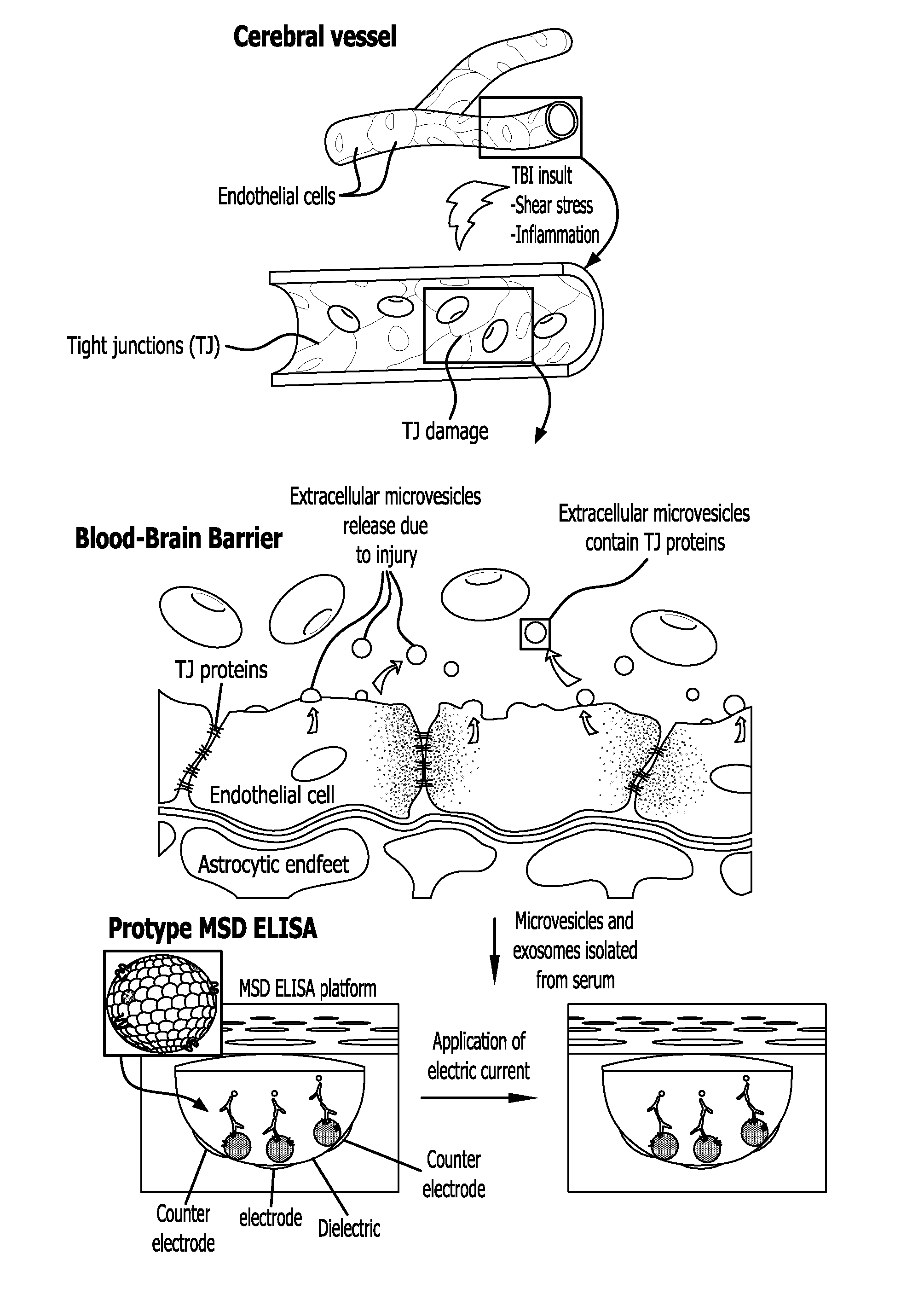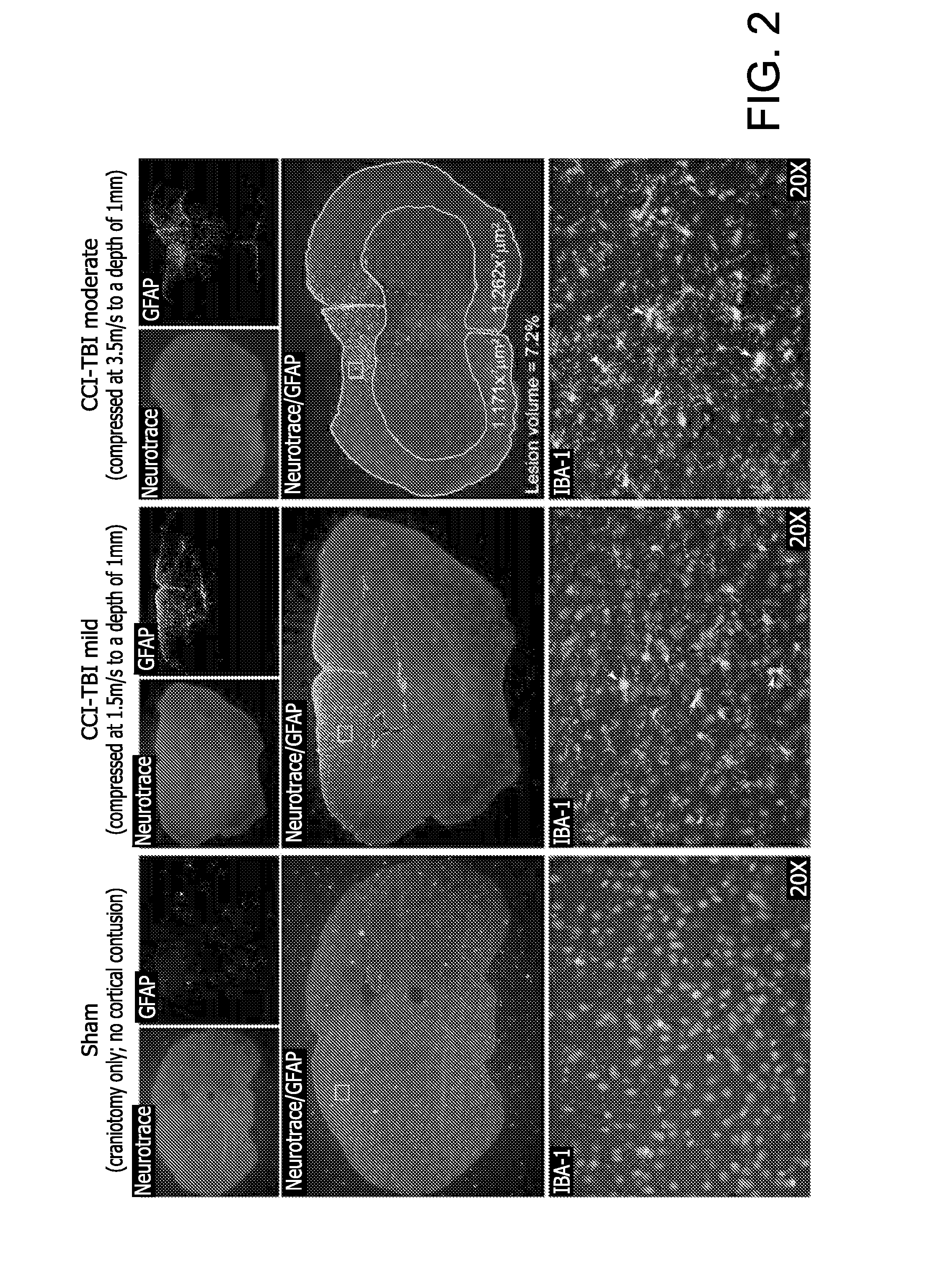Method for detecting injury to the brain
a brain injury and brain injury technology, applied in the field of brain injury detection, can solve the problems of death and disability, traumatic brain injury (tbi) is considered to be a major health problem, and tbi is particularly devastating among young adults and children, so as to improve the detection and management of secondary brain injury
- Summary
- Abstract
- Description
- Claims
- Application Information
AI Technical Summary
Benefits of technology
Problems solved by technology
Method used
Image
Examples
example 1
Characterization of the Spectrum of Altered TJ Protein Expression in CNS Vessels after TBI
[0156]The following experiments were carried out to evaluate the status of TJ integrity in the brain following injury using the Controlled Cortical Impact (CCI) model.
Traumatic Brain Injury (TBI) by Controlled Cortical Impact (CCI)
[0157]Using the Controlled Cortical Impact (CCI) experimental mouse model of TBI the status of the T J integrity following injury was evaluated (Elliott M B, Jallo J J, Barbe M F, Tuma R F. Brain Res. 2009. 1305:183-91). The animal protocol used for these studies has undergone full review and approval (#3415, approved on Nov. 9, 2010) by the Temple University School of Medicine Institutional Animal Care and Use Committee (IACUC). A week after arrival, CS7BL / 6 mice (purchased from Taconic Inc, Hudson, N.Y.) were placed into the following groups: untreated (no craniotomy and no TBI), craniotomy only (sham control), mild CCI-TBI, moderate CCI-TBI and severe CCI-TBI. Anes...
example 2
Isolation of Exosomes by Precipitation
[0166]Microvesicles / exosomes were isolated from two sources 1) tissue culture media and 2) from blood plasma collected from either experimental TBI animal samples or human samples. Media from BMVEC, D3 and b-End3 cell cultures exposed to different concentrations of various inflammatory mediators was also used. To induce inflammatory insult the following mediators were used: TNFα (50-100 ng / ml; BD Diagnostics, Franklin Lakes, N.J.), IL1β (100 ng / ml, BD Diagnostics), CCL2 / MCP-1 (Peprotech Inc, Rocky Hill, N.J.), CCL5 / RANTES (Peprotech Inc.), Lipopolysaccharide (LPS) from Escherichia coli 0127:B8 (20 ng / ml, Sigma Aldrich, St Louis, Mo.). After exposure endpoint (4 hrs and 24 hrs), collected conditioned media was centrifuged at 3000×g for 15 minutes in order to remove cells and cell debris. For blood samples, blood was allowed to coagulate for 10-15 minutes and then plasma was separated by centrifugation at 10000×g for 10 minutes. Exosomes were isol...
example 3
Isolation of Exosomes by Ultracentrifugation
[0167]Exosomes can also be isolated by a series of ultra-centrifugations. First the conditioned medium or serum sample (applicable also for CSF) is precleared of cells, dead cells and cellular debris by centrifugation in 50-ml centrifuge tubes for 20 min at 2,000×g in 4° C. The supernatant is then collected and the pellet discarded. In order to minimize contamination, approximately half a centimeter of supernatant is left behind on top of the pellet. The supernatant are then transferred to polyallomer or polycarbonate bottles (appropriate for ultracentrifugation). Next the samples are placed in an ultracentrifuge and spun for 30 min at 10,000×g in 4° C. These supernatants are then transferred to a fresh tube. Caution is taken to ensure that none of the pellet is collected and contaminates the supernatant. At this step the samples are again spun but at higher centrifugation speeds, using at least 70 min at 100,000×g, in 4° C. Note that thes...
PUM
| Property | Measurement | Unit |
|---|---|---|
| diameter | aaaaa | aaaaa |
| length | aaaaa | aaaaa |
| pore size | aaaaa | aaaaa |
Abstract
Description
Claims
Application Information
 Login to View More
Login to View More - R&D
- Intellectual Property
- Life Sciences
- Materials
- Tech Scout
- Unparalleled Data Quality
- Higher Quality Content
- 60% Fewer Hallucinations
Browse by: Latest US Patents, China's latest patents, Technical Efficacy Thesaurus, Application Domain, Technology Topic, Popular Technical Reports.
© 2025 PatSnap. All rights reserved.Legal|Privacy policy|Modern Slavery Act Transparency Statement|Sitemap|About US| Contact US: help@patsnap.com



